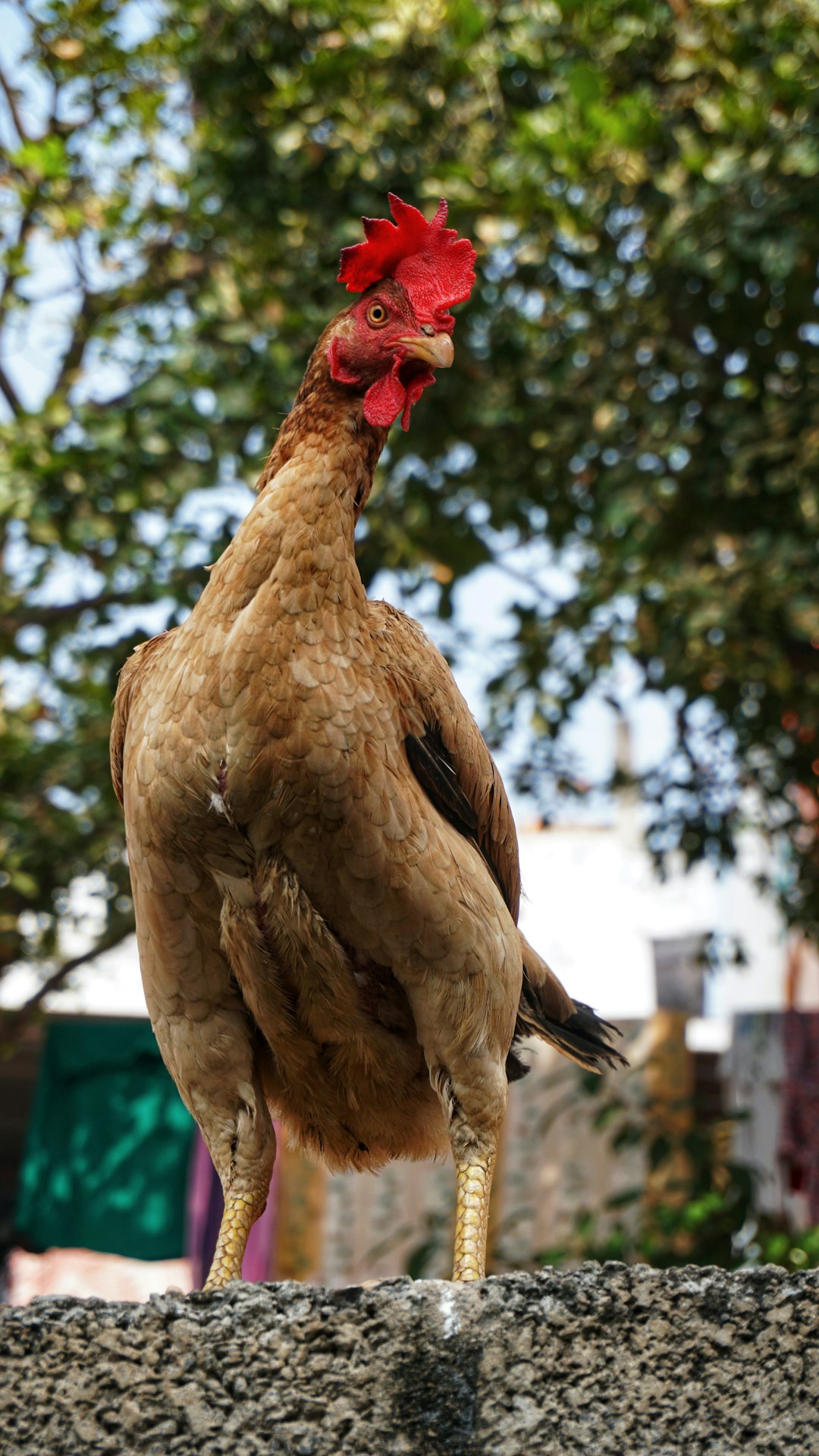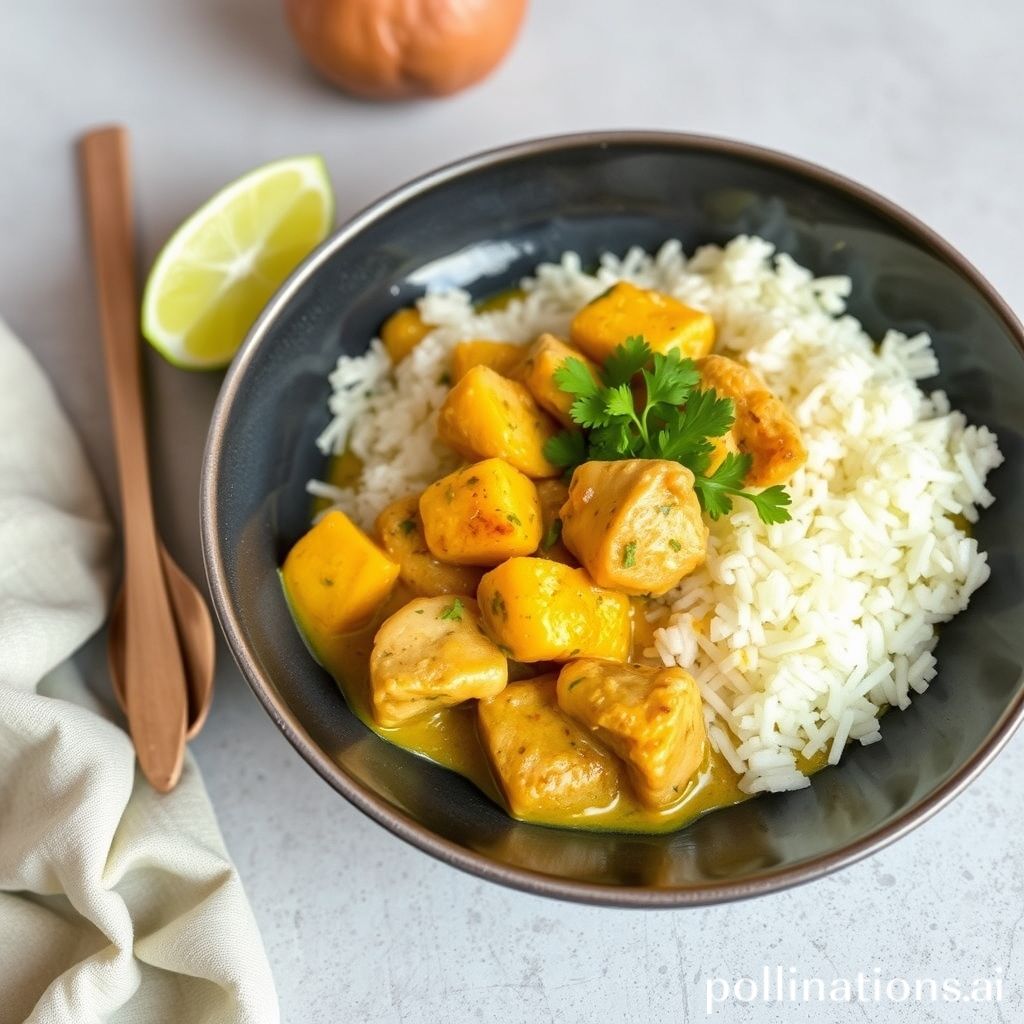Table of Contents
- Introduction
- Ingredients needed for Coconut Curry Chicken
- Step-by-step preparation process
- Tips for perfecting the flavor balance
- Variations and customization options
- Serving suggestions and side dishes
- Nutritional information and health benefits
- Common mistakes to avoid
- Frequently asked questions about Coconut Curry Chicken
- Conclusion
- Frequently Asked Questions
Introduction
Imagine a dish that whisks you away to a tropical paradise with just one bite. The tantalizing aroma of coconut mingling with perfectly spiced chicken is enough to make anyone’s mouth water. This isn’t just any ordinary curry – it’s an exotic adventure for your taste buds. Ready to embark on this culinary journey?
Gather these ingredients to start:
- 1.5 lbs chicken breast, cut into bite-sized pieces
- 1 can (14 oz) coconut milk
- 2 tbsp curry powder
- 1 medium onion, finely chopped
- 3 cloves garlic, minced
- 1 tbsp fresh ginger, grated
- 1 red bell pepper, sliced
- 1 tbsp soy sauce
- 1 tbsp fish sauce
- 1 tbsp brown sugar
- Salt and pepper, to taste
- Fresh cilantro, for garnish
- Steamed rice, to serve
With these ingredients at hand, you’re just a few steps away from creating a dish that’s as beautiful to look at as it is delicious to eat. Follow along, and let’s master the art of crafting the perfect Coconut Curry Chicken.
Ingredients needed for Coconut Curry Chicken
Coconut Curry Chicken is a delightful and flavorful dish, perfect for anyone who enjoys a blend of spices and creamy textures. To make this dish, you’ll need a variety of ingredients to build its rich and aromatic profile. Key ingredients include:
Chicken: Use boneless, skinless chicken breasts or thighs, cut into bite-size pieces.
Coconut Milk: Provides the creamy base for the curry, balancing the spices with its richness.
Onions and Garlic: Essential for building the savory foundation of the curry.
Ginger: Freshly grated ginger adds a zingy warmth.
Curry Powder: The star spice blend that gives the dish its name and distinct flavor.
Turmeric: Adds color and an earthy note.
Cumin and Coriander: Provide depth and a slightly nutty flavor.
Tomato Paste: Adds a tangy, rich layer to the curry sauce.
Chicken Broth: Helps to thin the sauce to your desired consistency.
Vegetables: Common additions include bell peppers, tomatoes, and spinach for extra nutrition and color.
Fresh Cilantro: Used as a garnish to add a fresh, herbaceous finish. Additionally, you may want to have salt, pepper, and olive oil on hand for seasoning and cooking.
Step-by-step preparation process
Preparing coconut curry chicken is a delightful culinary experience that rewards you with a flavorful meal. To start, gather all necessary ingredients: chicken breasts, coconut milk, curry powder, garlic, ginger, onions, bell peppers, tomatoes, and spices such as salt, pepper, and turmeric.
First, cut the chicken into bite-sized pieces. In a large pan, heat some oil over medium heat. Add diced onions, minced garlic, and grated ginger, and sauté until fragrant. Next, add the chicken pieces to the pan, seasoning with salt and pepper. Cook until the chicken is no longer pink.
Once the chicken is cooked, stir in curry powder and turmeric, ensuring the chicken is well-coated. Add diced bell peppers and tomatoes, cooking until the vegetables are tender. Pour in the coconut milk, stirring to combine all ingredients. Bring the mixture to a simmer and let it cook for about 15 minutes, allowing the flavors to meld together.
Taste and adjust seasoning as needed. Serve the coconut curry chicken hot, garnished with fresh cilantro and accompanied by steamed rice or naan bread. Enjoy the rich and aromatic flavors of this comforting dish!
Tips for perfecting the flavor balance
Perfecting the flavor balance in Coconut Curry Chicken requires careful attention to several key elements. First, the choice of coconut milk is critical. Opt for a high-quality full-fat coconut milk to ensure a rich and creamy base. Next, consider the balance of spices. A combination of turmeric, cumin, coriander, and garam masala provides a robust and aromatic foundation. However, be mindful not to overpower the dish; start with smaller amounts and adjust as needed.
Fresh ingredients can make a significant difference. Use freshly minced garlic and ginger to enhance the depth of flavor. Additionally, adding vegetables like bell peppers, carrots, and snap peas not only improves the nutritional value but also adds a layer of complexity and texture.
Don’t forget to balance the sweetness and acidity. A splash of lime juice and a teaspoon of sugar can work wonders to brighten the dish and harmonize the flavors. Lastly, always taste as you go. Cooking is an iterative process, and small adjustments can lead to a perfectly balanced Coconut Curry Chicken that delights the palate.
Variations and customization options
Coconut Curry Chicken is a versatile dish that lends itself well to various modifications and customizations, making it a favorite in many households. One of the most common variations is to adjust the level of spiciness. By adding more chili peppers or using a different type of curry powder, you can transform the dish from mild to intensely spicy. For those who prefer a milder flavor, consider using a sweet curry powder or reducing the amount of chili.
Vegetables can also be added to enhance the nutritional value and flavor of the dish. Common additions include bell peppers, spinach, and tomatoes, but feel free to experiment with your favorite vegetables. For a richer texture, you can add a dollop of yogurt or cream towards the end of the cooking process.
If you’re looking to make the dish healthier, consider using low-fat coconut milk and lean chicken breasts. For a vegetarian version, substitute the chicken with tofu or chickpeas. You can also serve Coconut Curry Chicken over different types of grains such as rice, quinoa, or couscous, depending on your dietary preferences.
Customization options are virtually endless, allowing you to create a Coconut Curry Chicken recipe that perfectly fits your taste and lifestyle.
Serving suggestions and side dishes
When it comes to serving Coconut Curry Chicken, there are numerous side dishes that can complement its rich and creamy flavors. A classic choice is steamed jasmine rice, which acts as a neutral base that absorbs the savory curry sauce perfectly. If you’re looking for a healthier alternative, quinoa or brown rice are excellent substitutes.
Vegetables are another fantastic option to round out your meal. Consider serving roasted or steamed vegetables like broccoli, green beans, or asparagus. These veggies add a delightful crunch and balance the rich flavors of the curry. A fresh cucumber salad with lime and cilantro can also add a refreshing contrast.
Naan bread or roti are traditional options that pair wonderfully with Coconut Curry Chicken. They are perfect for scooping up every last bit of the delicious sauce. For something a bit different, consider serving the curry over a bed of mashed sweet potatoes, which can add a touch of sweetness that complements the coconut milk in the curry.
Finally, don’t forget to garnish your Coconut Curry Chicken with fresh herbs like cilantro or basil, a wedge of lime, and a sprinkle of toasted coconut flakes to elevate the dish to the next level.
Nutritional information and health benefits
Coconut curry chicken is not only a flavorful dish but also offers several nutritional benefits. This dish is typically high in protein due to the chicken, which is essential for muscle repair and growth. Additionally, the use of coconut milk provides a good source of healthy fats, particularly medium-chain triglycerides (MCTs), which are known for their quick energy release and potential to aid in weight management.
The curry spices such as turmeric, cumin, and coriander contain antioxidants and anti-inflammatory properties. Turmeric, in particular, is renowned for its active compound curcumin, which has been studied for its potential to reduce inflammation and boost brain health. Vegetables like bell peppers, onions, and spinach often used in coconut curry chicken add fiber, vitamins, and minerals, increasing the overall nutritional value of the dish.
Though coconut curry chicken can be calorie-dense due to the coconut milk, choosing light coconut milk or reducing the portion size can help manage calorie intake. Overall, it provides a balanced meal with protein, healthy fats, and essential nutrients, making it a nutritious choice when prepared mindfully.
Common mistakes to avoid
When preparing Coconut Curry Chicken, several common mistakes can impact the dish’s flavor and texture. One frequent error is using low-quality coconut milk. Always opt for full-fat, creamy coconut milk to achieve a rich and luscious curry. Another mistake is not sautéing spices properly. Ensure you toast spices like cumin, coriander, and turmeric in oil before adding other ingredients to enhance their flavors.
Overcrowding the pan can prevent the chicken from browning correctly, leading to a less flavorful curry. Cook the chicken in batches if necessary. Additionally, undercooking or overcooking the chicken can ruin the dish. Cook the chicken until it’s just done to keep it tender and juicy. Forgetting to season the curry adequately is another pitfall. Taste your curry frequently and adjust the salt and spice levels to ensure a balanced flavor.
Lastly, ignoring the power of fresh herbs and garnishes can make your curry seem flat. Fresh cilantro, basil, or lime juice can elevate the dish and add vibrant, fresh flavors. By avoiding these common mistakes, you’ll be well on your way to creating a delicious Coconut Curry Chicken that everyone will love.
Frequently asked questions about Coconut Curry Chicken
Coconut Curry Chicken is a delightful and popular dish that combines the richness of coconut milk with the aromatic flavors of curry spices. Many people have questions about how to make this dish perfect and enjoyable.
One common question is about the type of chicken to use. Both boneless, skinless chicken breasts, and thighs work well, but thighs tend to be juicier and more flavorful. Another frequently asked question is about the type of curry paste to use. You can use either red or yellow curry paste, depending on your preference. Red curry paste is spicier, while yellow curry paste offers a milder flavor.
People often ask about substituting coconut milk with other ingredients. If you prefer a lighter dish, you can use light coconut milk, but this may affect the dish’s creaminess. Some even ask if they can make it vegetarian. Absolutely! Substitute the chicken with tofu, chickpeas, or vegetables like cauliflower and bell peppers for a tasty vegetarian version.
Many also wonder about side dishes. Coconut Curry Chicken pairs well with jasmine rice, naan bread, or quinoa to soak up the delicious sauce.
Conclusion
Mastering the perfect Coconut Curry Chicken is easier than ever with our comprehensive guide. From selecting the freshest ingredients to balancing intricate flavors and exploring endless customization options, you’re well on your way to creating a dish that’s as nutritious as it is delicious. Elevate your culinary skills, avoid common pitfalls, and serve up a dish that’s sure to impress.
Why stop at one exceptional recipe? Dive into a world of culinary delights with The Chicken Bible: Say Goodbye to Boring Chicken with 500 Recipes for Easy Dinners, Braises, Wings, Stir-Fries, and So Much More. This book is your ticket to transforming every chicken meal into a memorable feast. Purchase your copy today and unlock a treasure trove of delicious possibilities!

